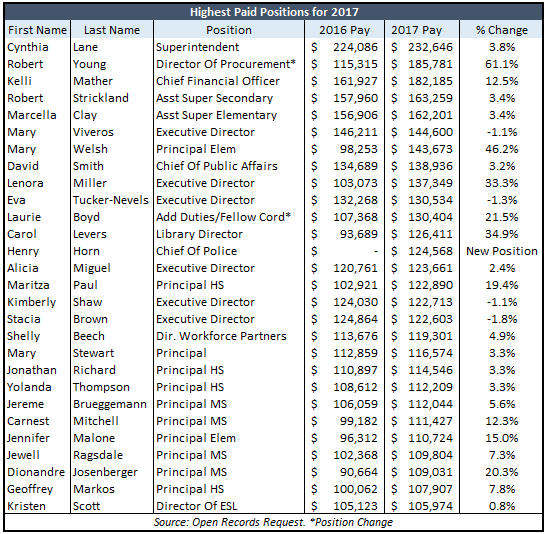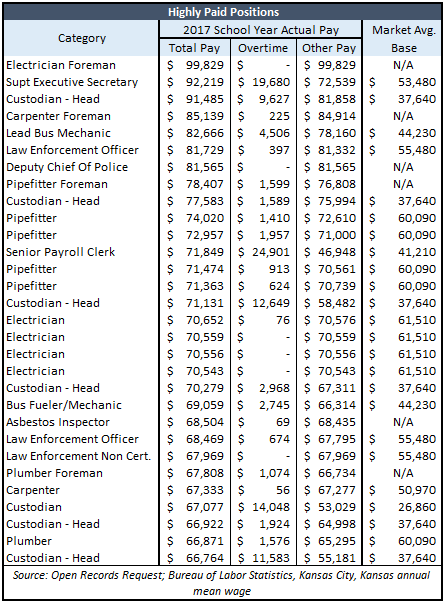The Kansas City school district, one of several Kansas districts using taxpayer money to sue for more funding, managed to provide  some pretty hefty pay increases for top management last year. Total pay for the Kansas City school district increased by 3.8 percent to $168.8 million but teachers saw very little increase. Collectively, those identified by the district as teachers saw their pay increase by just 1.4 percent while pay for all other district employees jumped by an average of 6.8 percent.
some pretty hefty pay increases for top management last year. Total pay for the Kansas City school district increased by 3.8 percent to $168.8 million but teachers saw very little increase. Collectively, those identified by the district as teachers saw their pay increase by just 1.4 percent while pay for all other district employees jumped by an average of 6.8 percent.
An Open Records request shows several of the highest paid employees received double-digit pay increases over the last school year. Chief Financial Officer Kelli Mather took home $182,185 last school year; that’s a 12.5 percent increase coming on top of a 7.7 percent increase the year before. Other double-digit pay jumps went to an elementary principle (46.2 percent), an executive director of an unspecified program (33.3 percent), the library director (34.9 percent) and four other principals had increases ranging from 12.3 percent to 20.3 percent. Two other large increases seem associated with position changes.
 Chief of Public Affairs David Smith offered several explanations for some of the increases, including across the board increases of 2 percent and payout of unused sick leave. Smith said, “…staff who were hired before August, 1996 are eligible to receive payout for their unused disability days (if they have accrued 20 years of service and age 55, or 30 years of service).” This is a rather common practice in government but somewhat rare in the private sector.
Chief of Public Affairs David Smith offered several explanations for some of the increases, including across the board increases of 2 percent and payout of unused sick leave. Smith said, “…staff who were hired before August, 1996 are eligible to receive payout for their unused disability days (if they have accrued 20 years of service and age 55, or 30 years of service).” This is a rather common practice in government but somewhat rare in the private sector.
An initial attempt was made to blame some of the pay increases on rising health insurance costs even though our Open Records request stipulated that benefit costs were not to be included. Smith said insurance costs must be included in pay totals because “…they are included in tax returns that employees file with the Internal Revenue Service.” But that isn’t true. Presented with IRS documentation confirming that insurance benefits are not taxable, Smith backed off his blanket statement and said, “The following staff members, as a part of their compensation package, are offered employee-provided health insurance for either family coverage or spousal coverage:
- Family Coverage: Lane, Strickland, Mather, Clay, Smith, Horn
- Spousal Coverage: Viveros, Nevels, Shaw, Miguel, Brow
For staff who receive this coverage, the amount the district pays is included in the figures provided to you.” The implication seems to be that other employees pay a portion of their insurance costs but not the listed administrators. Chief Financial Officer Kelli Mather would not respond to a request for confirmation that the district had accurately complied with the Open Records request and David Smith ignored also ignored a request for clarification on the insurance claims he made. Unfortunately, the district has consistently adopted a posture of obfuscation on Open Records requests over the years.
Smith also noted that non-teaching staff were required to take three or four unpaid furlough days in the prior year but not this past year, giving the appearance of about a 1 percent increase for those employees. The furlough requirement was imposed by the district school board for alleged state funding shortfalls rather than take advantage of other available options. The school board could have used some of the $67 million built up in operating cash reserves, most of which came from aid provided to educate students in prior years but wasn’t spent. They also could have implemented a number of efficiency recommendations if the district wanted to reduce costs, including outsourcing maintenance and other functions provided by overly expensive employees.
A July 2013 Legislative Post Audit efficiency study on the Kansas City school district included page after page of recommendations to bring district spending in line with market conditions and reduce costs. One recommendation was “Reduce Custodial and Maintenance Positions and Salaries” since some salaries were found to  be more than 20% higher than paid in the private sector and the district had more staff than comparable districts. As shown on the adjacent table, the district continues to spend far more than necessary on many such positions (including others not listed), apparently expecting citizens to be ordered to pay higher taxes so that the district can continue waste money.
be more than 20% higher than paid in the private sector and the district had more staff than comparable districts. As shown on the adjacent table, the district continues to spend far more than necessary on many such positions (including others not listed), apparently expecting citizens to be ordered to pay higher taxes so that the district can continue waste money.
Gross pay less overtime for custodians, mechanics, pipefitters, carpenters and even police officers are much higher that the market average base pay for Kansas City according to the Bureau of Labor Statistics. Some positions aren’t listed in the BLS directory but the every position in the adjacent table where comparisons can made shows the district paying significantly higher than the market average. And the economic feasibility of positions such as pipefitters, electricians, carpenters and asbestos inspector on staff rather than outsourced as-needed is another matter likely causing individuals and employers to be unnecessarily taxed.
The complete list of employee compensation for the Kansas City school district is available at KansasOpenGov.org.




